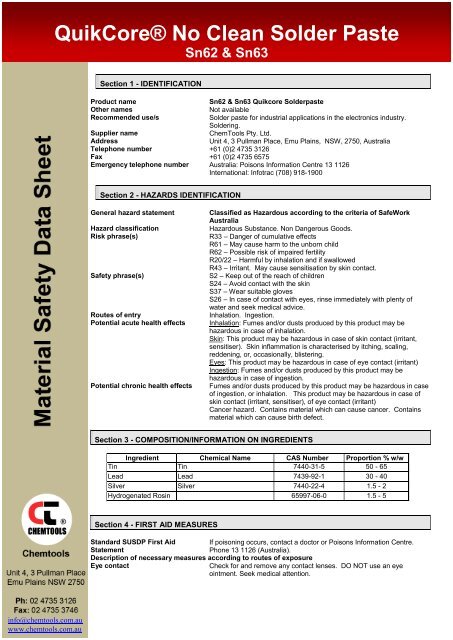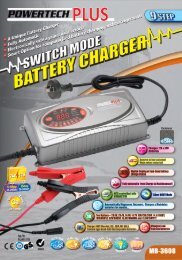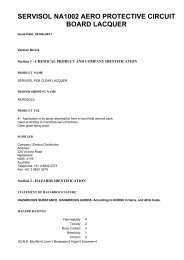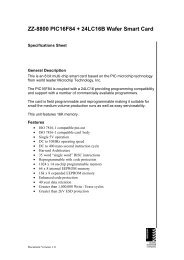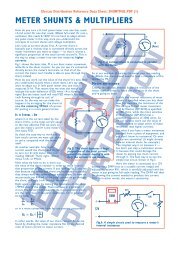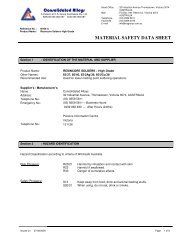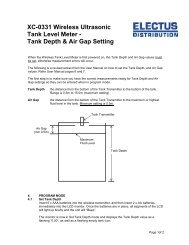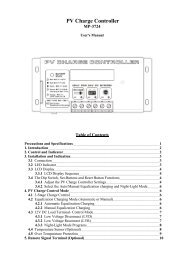QuikCore® No Clean Solder Paste - Jaycar Electronics
QuikCore® No Clean Solder Paste - Jaycar Electronics
QuikCore® No Clean Solder Paste - Jaycar Electronics
- No tags were found...
You also want an ePaper? Increase the reach of your titles
YUMPU automatically turns print PDFs into web optimized ePapers that Google loves.
<strong>QuikCore®</strong> <strong>No</strong> <strong>Clean</strong> <strong>Solder</strong> <strong>Paste</strong>Sn62 & Sn63Section 1 - IDENTIFICATIONProduct nameOther namesRecommended use/sSn62 & Sn63 Quikcore <strong>Solder</strong>paste<strong>No</strong>t available<strong>Solder</strong> paste for industrial applications in the electronics industry.<strong>Solder</strong>ing.ChemTools Pty. Ltd.Unit 4, 3 Pullman Place, Emu Plains, NSW, 2750, Australia+61 (0)2 4735 3126+61 (0)2 4735 6575Supplier nameAddressTelephone numberFaxEmergency telephone number Australia: Poisons Information Centre 13 1126International: Infotrac (708) 918-1900Section 2 - HAZARDS IDENTIFICATIONGeneral hazard statementHazard classificationRisk phrase(s)Safety phrase(s)Routes of entryPotential acute health effectsPotential chronic health effectsClassified as Hazardous according to the criteria of SafeWorkAustraliaHazardous Substance. <strong>No</strong>n Dangerous Goods.R33 – Danger of cumulative effectsR61 – May cause harm to the unborn childR62 – Possible risk of impaired fertilityR20/22 – Harmful by inhalation and if swallowedR43 – Irritant. May cause sensitisation by skin contact.S2 – Keep out of the reach of childrenS24 – Avoid contact with the skinS37 – Wear suitable glovesS26 – In case of contact with eyes, rinse immediately with plenty ofwater and seek medical advice.Inhalation. Ingestion.Inhalation: Fumes and/or dusts produced by this product may behazardous in case of inhalation.Skin: This product may be hazardous in case of skin contact (irritant,sensitiser). Skin inflammation is characterised by itching, scaling,reddening, or, occasionally, blistering.Eyes: This product may be hazardous in case of eye contact (irritant)Ingestion: Fumes and/or dusts produced by this product may behazardous in case of ingestion.Fumes and/or dusts produced by this product may be hazardous in caseof ingestion, or inhalation. This product may be hazardous in case ofskin contact (irritant, sensitiser), of eye contact (irritant)Cancer hazard. Contains material which can cause cancer. Containsmaterial which can cause birth defect.Section 3 - COMPOSITION/INFORMATION ON INGREDIENTSIngredient Chemical Name CAS Number Proportion % w/wTin Tin 7440-31-5 50 - 65Lead Lead 7439-92-1 30 - 40Silver Silver 7440-22-4 1.5 - 2Hydrogenated Rosin 65997-06-0 1.5 - 5Section 4 - FIRST AID MEASURESStandard SUSDP First AidStatementDescription of necessary measures according to routes of exposureEye contactIf poisoning occurs, contact a doctor or Poisons Information Centre.Phone 13 1126 (Australia).Check for and remove any contact lenses. DO NOT use an eyeointment. Seek medical attention.info@chemtools.com.auwww.chemtools.com.au
<strong>QuikCore®</strong> <strong>No</strong> <strong>Clean</strong> <strong>Solder</strong> <strong>Paste</strong>Skin contactHazardous skin contactInhalationHazardous inhalationIngestionHazardous ingestionSn62 & Sn63Prolonged and repeated contact with bare skin may cause irritation.Wash gently and thoroughly the contaminated skin with running waterand non-abrasive soap.MOLTEN METAL can cause SEVERE BURNS. In case of burns: Holdburnt area under cold running water for at least 15 minutes. Cover withantiseptic ointment and sterile gauze. Seek IMMEDIATE medicalattention.Allow the victim to rest in a well-ventilated area. Seek immediatemedical attention.Fumes in high concentrations: May be harmful if inhaled. If the victim isnot breathing, perform mouth-to-mouth resuscitation. SEEKIMMEDIATE MEDICAL ATTENTION.Remove dentures if any. Have conscious person drink several glassesof water or milk. INDUCE VOMITING BY sticking finger in throat. Lowerthe head so that the vomit will not re-enter the mouth and throat.NEVER give an unconscious person anything to ingest. Seekimmediate medical attention.<strong>No</strong> additional informationIndication of medical attention and special treatment needed including description of most importantsymptoms, acute and delayedAggravated medical conditionscaused by exposure:Repeated exposure to toxic material may produce general deteriorationof health by an accumulation in one or many human organs.Section 5 - FIREFIGHTING MEASURESSuitable extinguishing media Small fire: Use DRY chemical powder.Large fire: Use water spray, fog or foam. NO water jet.Hazards from combustion products Products are carbon oxides; carbon monoxide and carbon dioxide.Some metallic oxides. Depending on conditions, some aliphaticaldehydes and carboxylic acids may also be formed.Special protective precautionsSpecial equipment for fire fighters: Use an approved/certified respirator or equivalentHazchem Code:Special remarks on fire hazards: Metallic part of product is non-flammable. The organic medium may burnif exposed to direct flame. <strong>No</strong>n explosive in presence of shocks, ofheat.Section 6 - ACCIDENTAL RELEASE MEASURESEmergency proceduresMethods and materials forcontainment and clean upSmall spill and leak – MOLTEN METAL: Let cool before picking up andreturning to process or recycling. OTHER: Use appropriate tools to putthe spilled solid in a container reserved to that effect.Large spill – Our data base contains no additional information in case ofa large spill and/or leak of the product.Section 7 - HANDLING AND STORAGEPrecautions for safe handlingConditions for safe storage,including any incompatibilitiesWear suitable protective clothing. Use in a well ventilated area. Whenusing, do not eat, drink or smoke. Avoid contact with skin and eyes.After handling, always wash hands thoroughly with soap and water.Keep container dry. Keep in a cool place. Suspected carcinogenic,teratogenic or mutagenic materials should be stored in a separatelocked safety storage cabinet or room. Follow special instructions oncontainer and analysis reports for additional storage information.info@chemtools.com.auwww.chemtools.com.au
<strong>QuikCore®</strong> <strong>No</strong> <strong>Clean</strong> <strong>Solder</strong> <strong>Paste</strong>Sn62 & Sn63Section 8 - EXPOSURE CONTROLS/PERSONAL PROTECTIONNational exposure standardsBiological limit valuesEngineering controlsPersonal protective equipmentPersonal protection in case of alarge spillTinTWA: 2mg/m 3 from HSISLeadTWA: 0.15 mg/m 3 from HSISSilverTWA: 0.1 mg/m 3 from HSISRosin, hydrogenatedIf this product is heated to temperatures sufficient to produce smoke orfumes, the TLV-TWA of 0.1mg/m 3 (as formaldehyde, as per HSIS), forrosin core pyrolysis products should be observed.Use process enclosures, local exhaust ventilation, or other engineeringcontrols to keep airborne levels below recommended exposure limits. Ifuser operations generate dust, fume or mist, use ventilation to keepexposure to airborne contaminants below the exposure limit.HANDLING: gloves (disposable or vinyl), safety glasses or splashgoggles, lab coat.GENERAL USE: Use gloves [suitable to the operation], safety glassesor splash goggles; wear appropriate respirator when ventilation isinadequate. Be sure to use a MSHA/NIOSH approved respirator orequivalent. Suggested protective clothing may not be adequate for aspecific process. Consult a specialist before handling.<strong>No</strong> additional information.Section 9 - PHYSICAL AND CHEMICAL PROPERTIESAppearance (colour, physical Dark grey solid [paste].form, shape)OdourTypical rosin.pH<strong>No</strong>t applicable.Vapour pressure<strong>No</strong>t availableVapour density<strong>No</strong>t availableBoiling point/range<strong>No</strong>t availableFreezing/melting pointMelting point weighted average: 260 º CSolubility (specify solvent) Insoluble in water and oil, n-octanol, acetone, partially soluble indiethyl ether, very slightly soluble in methanol.Specific gravity or density Weighted average 4.91FlashpointFlammabilityUpper and lower flammable limitsIgnition temperatureViscosity350 to 1200 KcPs (see certificate for specific value)Ionicity (in water)<strong>No</strong>n-ionicDispersion propertiesIs not dispersed in cold water, hot water, n-octanol, acetone.Evaporation rate Lower than 1Water/Oil Dist. Coeff.CorrosivityCorrosive in presence of copper. The organic medium in the pastehas the task of cleaning (removing and preventing oxidation) thesurface for soldering.Section 10 - STABILITY AND REACTIVITYChemical stabilityConditions of instabilityConditions to avoidIncompatible materialsThe product is stable.Stable in normal conditions. Over the melting point will emit toxic leadand tin oxide fumes. A small amount of organic fumes may also beevolved.Reactive with oxidising agents.info@chemtools.com.auwww.chemtools.com.au
<strong>QuikCore®</strong> <strong>No</strong> <strong>Clean</strong> <strong>Solder</strong> <strong>Paste</strong>Hazardous decompositionproductsHazardous reactionsHazardous polymerisationSn62 & Sn63Lead and tin oxide fumes.Section 11 - TOXICOLOGICAL INFORMATIONHealth effects from likely routes of exposureToxicity to animalsHydrogenated RosinRat – Acute Oral LD50: 8400 mg/kgGuinea Pig – Acute Oral LD 50: 5000 mg/kgChronic effects on humansOther toxic effects on humansSpecial remarks on chronic effectson humansSpecial remarks on other toxiceffects on humansCarcinogenic effects: [Lead]: Classified + (Proven) by OSHA, A3(Proven for animal) by ACGIH, 2B (Possible for human) by IARC.[Rosen]: Classified 4 (Probably not for human) by IARC. [Rosenthermal decomposition product (as formaldehyde)]: Classified +(Proven) by NIOSH.Developmental toxicity: Proven [Lead].Mutagenic effects: <strong>No</strong>t available.Teratogenic effects: Classified 1 by European Union.The product may be toxic to lungs, upper respiratory tract, skin, eyes,blood, kidneys, the nervous system, the reproductive system, spleen,brain, digestive system, gastro-intestinal tract, eye, lens or cornea,thyroid.. Repeated or prolonged exposure to the substance canproduce target organs damage. Repeated or prolonged exposure tothe substance can produce target organs damage. Repeated exposureto toxic material may produce general deterioration of health by anaccumulation in one or many human organs.Human: Lead crosses the placental barrier.Overexposure to fumes may cause irritation to the respiratory tract,digestive system and to the eyes. Overexposure to tin oxide fumesmay results in benign pneumoconiosis (stannosis).Repeated and prolonged contact may cause skin irritation, dermatitisand/or an allergic skin reaction (sensitisation) in susceptible individuals.Inhalation of smoke or fumes, at high temperatures, may cause anasthmatic reaction in some individuals. Prolonged and repeatedcontact with bare skin may cause irritation or dermatitis. MOLTENMETAL can cause severe BURNS.Section 12 - ECOLOGICAL INFORMATIONEcotoxicityPersistence and degradabilityProducts of biodegradationToxicity of the products ofbiodegradationMobilityEnvironmental fateBioaccumulative potential<strong>No</strong>t available.<strong>No</strong>t available.Possibly hazardous short term degradation products are not likely.However, long term degradation products may arise.The products of degradation are less toxic than the product itself.<strong>No</strong>t available.<strong>No</strong>t available.<strong>No</strong>t available.Section 13 - DISPOSAL CONSIDERATIONSDisposal methods and containersSpecial precautions for landfill orincinerationWaste must be disposed of in accordance with local regulations.Section 14 - TRANSPORT INFORMATIONinfo@chemtools.com.auwww.chemtools.com.au
<strong>QuikCore®</strong> <strong>No</strong> <strong>Clean</strong> <strong>Solder</strong> <strong>Paste</strong>Sn62 & Sn63Dangerous Goods Classification <strong>No</strong>t a Dangerous Good (ADG Code)UN Number<strong>No</strong>t applicableUN Proper Shipping Name <strong>No</strong>t applicableClass and subsidiary risk<strong>No</strong>t applicablePacking Group<strong>No</strong>t applicableSpecial precautions for userHazchem Code<strong>No</strong>t applicableIMDG Classification<strong>No</strong>t controlledIATA Classification<strong>No</strong>t controlledADR/RID Classification<strong>No</strong>t controlled (Europe)Section 15 - REGULATORY INFORMATIONThe regulatory status of a material (including its ingredients) under relevant Australian health, safetyand environmental legislationPoisons Scheduling (Australia Based on the ingredients this product is not a scheduled poison.SUSDP)Additional national and/or international regulatory informationClassificationsWHMIS (Canada) WHMIS CLASS B-2: Flammable liquid with a flashpoint lower than 37.8 ºC. WHMIS CLASS D-2A: Material causing othertoxic effects (VERY TOXIC)Section 16 - OTHER INFORMATIONDate of preparation or lastrevision of this MSDSKey/legend to abbreviationsand acronyms used in theMSDSApril 2010IATA – International Air Transport AssociationWHMIS – Workplace Hazardous Materials Information SystemHMIS – Hazardous Materials Information SystemACGIH – American Conference of Government Industrial HygienistsIARC – Inter Agency Regulatory CouncilNOHSC – National Occupational Health and Safety Commission(Australia)SUSDP – Standard for the Uniform Scheduling of Drugs and Poisons(Australia)STEL – Short Term Exposure LimitOSHA – Occupational Safety and Health AdministrationNTP – National Toxicology ProgramPEL – Permissible Exposure LimitTWA – Time Weighted Averages TLV - Threshold Limit ValueNIOSH – National Institute of Occupational Health and Safety<strong>No</strong>tice to readerTo the best of our knowledge, the information contained herein is accurate. However, neither the above-namedsupplier, nor any of its subsidiaries, assumes any liability whatsoever for the accuracy or completeness of theinformation contained herein.Final determination of suitability of any material is the sole responsibility of the user. All materials may presentunknown hazards and should be used with caution. Although certain hazards are described herein, we cannotguarantee that these are the only hazards that exist.End of MSDSinfo@chemtools.com.auwww.chemtools.com.au


